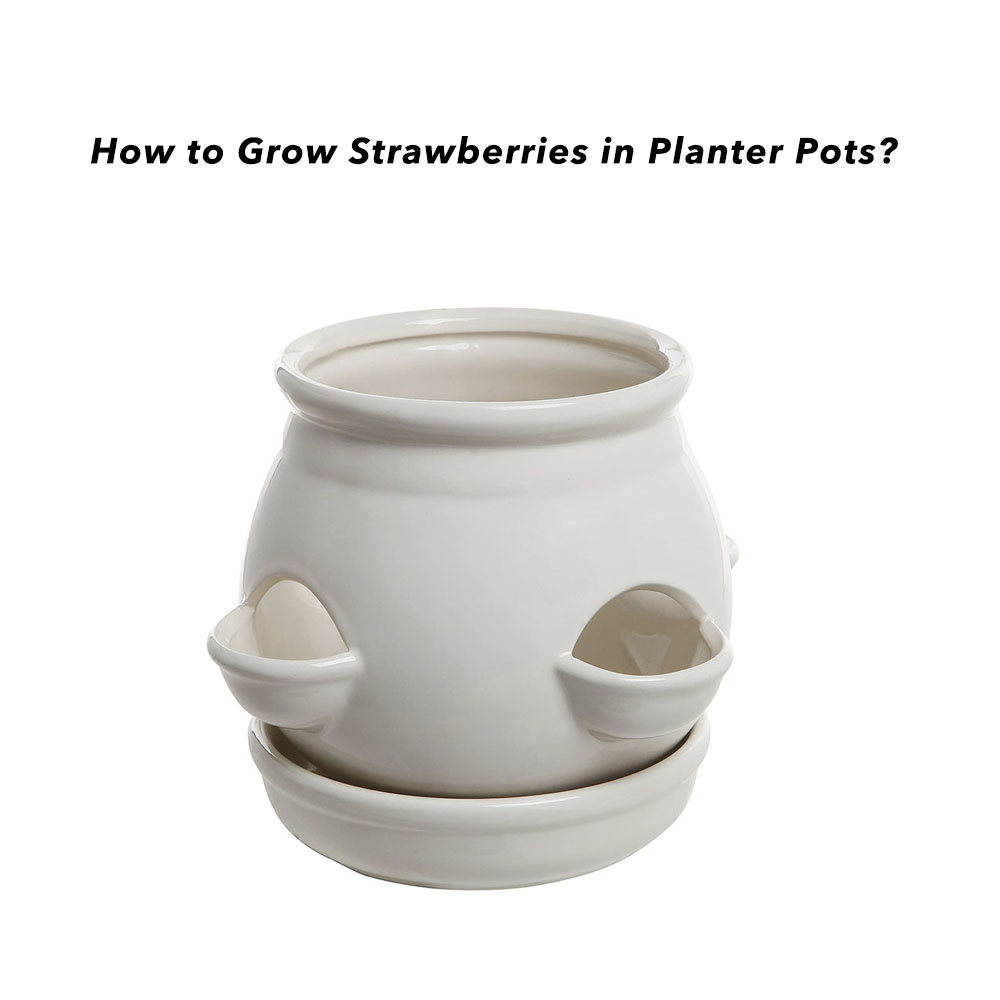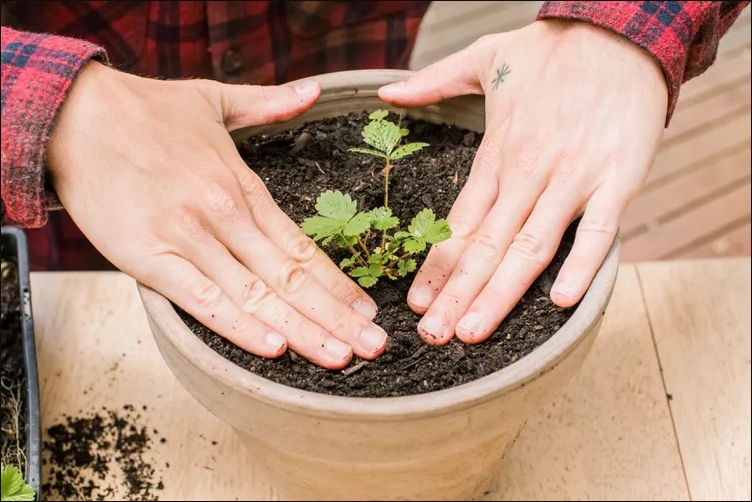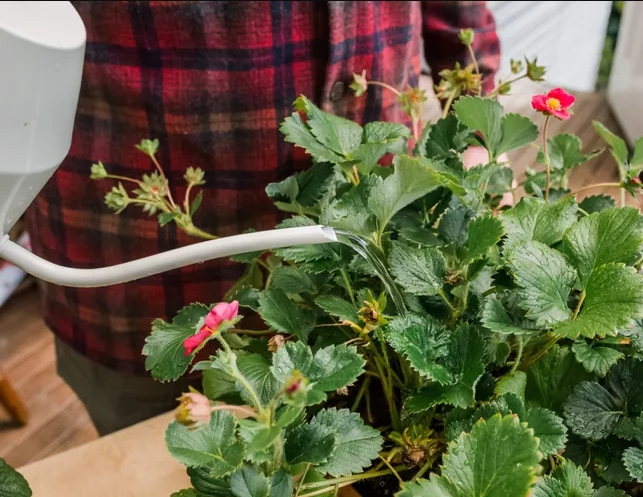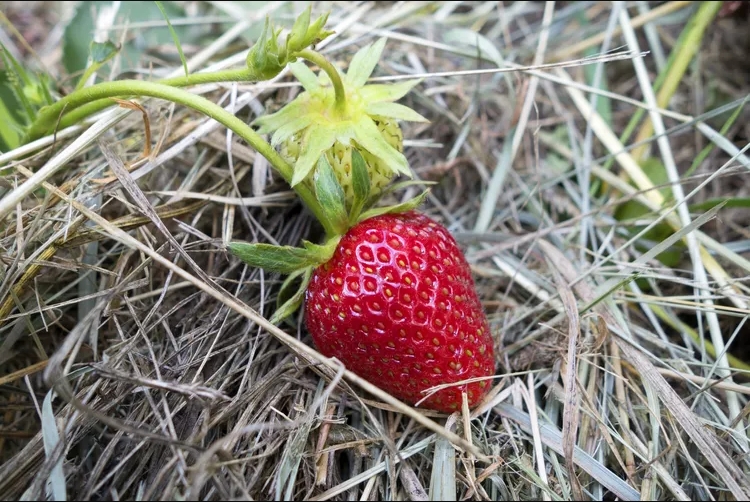How to Grow Strawberries in Planter Pots?
Time of issue: 2024-04-08 12:08:50- Why Grow Strawberries in Pots?
- When to Plant Strawberries in Pots
- What the Best Pots for Strawberry?
- Terracotta Pots: Timeless Charm and Functionality
- Ceramic Pots: Style Meets Practicality
- How to Plant Strawberries in Pots
- How to Care for Strawberry Plants in Pots
- Prepare the Plants
- Add Soil
- Plant the Strawberries
- Place the Container
- Water the Plants
- Feed Your Strawberries
- Propagating Potted Strawberries
- When and How to Harvest Strawberries in Pots
- Conclusion

Strawberries are a favorite among gardeners, and growing them in pots opens up a world of possibilities for even the smallest of spaces. Whether you have a sunny balcony, patio, or limited garden space, cultivating strawberries in planter pots offers numerous benefits and rewards. Let's delve into the ins and outs of growing strawberries in planter containers and discover how to nurture these sweet treats to perfection.
Why Grow Strawberries in Pots?
Growing strawberries in planter pots provides several advantages, including the ability to control soil quality, moisture levels, and sunlight exposure. Pots also offer flexibility, allowing you to move your strawberry plants to optimize growing conditions throughout the season. Additionally, cultivating strawberries in planter containers can help prevent soil-borne diseases and pests, leading to healthier plants and higher yields.
Maximizing Space
One of the most compelling reasons to grow strawberries in planter pots is the ability to maximize limited gardening space. Whether you have a small balcony, patio, or even just a sunny windowsill, pots allow you to grow strawberries in areas where traditional garden beds may not be feasible. This makes container gardening an excellent option for urban dwellers or anyone with limited outdoor space.
Controlled Environment
Containers offer greater control over growing conditions, allowing you to tailor the environment to suit the specific needs of your strawberry plants. You can easily adjust factors such as soil composition, moisture levels, and sunlight exposure to optimize plant health and productivity. This level of control can be particularly beneficial in regions with challenging climates or soil conditions.
Portability
The portability of pots allows you to move your strawberry plants as needed to optimize growing conditions throughout the season. You can place pots in sunnier or shadier spots as the weather changes or bring them indoors during periods of extreme heat or cold. This flexibility ensures that your strawberry plants receive the ideal conditions for growth and development, regardless of external factors.
Prevention of Pests and Diseases
Growing strawberries in planter pots can help prevent common pests and diseases that can plague plants grown in the ground. Containers offer a barrier against soil-borne pests and pathogens, reducing the risk of infestations and infections. Additionally, you can easily monitor your plants for signs of trouble and take prompt action to address any issues that arise.
Extended Growing Season
Container-grown strawberries often enjoy an extended growing season compared to those grown in the ground. Pots warm up more quickly in the spring, allowing you to plant strawberries earlier and enjoy an earlier harvest. Additionally, you can bring pots indoors during the cooler months to prolong the growing season and continue harvesting fresh berries well into the fall or winter.
When to Plant Strawberries in Pots
The best time to plant strawberries in planter pots depends on your local climate and the variety of strawberries you're growing. In general, spring is an ideal time to plant strawberries, as they prefer cool temperatures for establishment. Aim to plant your strawberries in planter pots a few weeks before the last frost date in your area to give them time to establish roots before the heat of summer sets in.
What the Best Pots for Strawberry?
When selecting pots for growing strawberries, opt for containers that are at least 8-12 inches deep and have ample drainage holes to prevent waterlogging. Terracotta, plastic, or ceramic pots are all suitable options, provided they allow for proper drainage and airflow. Consider using hanging baskets or vertical towers to maximize space and promote good air circulation around the plants.
Terracotta Pots: Timeless Charm and Functionality
Terracotta pots have long been cherished by gardeners for their rustic appeal and excellent drainage properties. Made from clay fired at high temperatures, terracotta pots are porous, allowing excess moisture to evaporate quickly and promoting airflow to the roots. This helps prevent waterlogging and root rot, which can be detrimental to strawberry plants. Additionally, terracotta pots provide a stable environment for the plants, helping to regulate soil temperature and moisture levels. Their classic appearance adds a touch of elegance to any garden or patio, making them a popular choice for growing strawberries.
Ceramic Pots: Style Meets Practicality
For those seeking a more modern and stylish option, ceramic pots offer a wide range of colors, patterns, and finishes to complement any aesthetic. Unlike terracotta pots, ceramic pots are non-porous, which means they retain moisture more effectively and require less frequent watering. This can be advantageous in hot or dry climates, where maintaining soil moisture levels can be challenging. Ceramic pots also provide excellent insulation, protecting the roots from temperature fluctuations and providing a stable growing environment for strawberry plants. With their versatility and visual appeal, ceramic pots are an attractive choice for showcasing strawberries in any indoor or outdoor setting.
How to Plant Strawberries in Pots
To plant strawberries in planter pots, start by filling the containers with a well-draining potting mix enriched with compost or aged manure. Plant strawberry crowns or runners at the same depth they were previously growing, ensuring that the crown is level with the soil surface. Space the plants 8-12 inches apart to allow for adequate root development and airflow. Water thoroughly after planting and keep the soil consistently moist but not waterlogged.
How to Care for Strawberry Plants in Pots
Proper care is essential for the health and productivity of your potted strawberry plants. Provide ample sunlight, ideally 6-8 hours of direct sunlight per day, to promote flowering and fruiting. Water regularly, especially during hot weather, and mulch around the plants to conserve moisture and suppress weeds. Fertilize strawberries in planter pots with a balanced fertilizer every 4-6 weeks during the growing season to support healthy growth and fruit production.
Prepare the Plants
Begin your strawberry-growing journey by selecting robust, healthy seedlings from a trusted nursery or garden center. Take care to inspect the roots and foliage, choosing plants free from signs of disease or stress. Before planting, gently tease out the roots and soak them in water for about an hour to ensure they're well-hydrated and ready to thrive in their new home.
Add Soil

Fill your ceramic pots with a premium-quality potting mix specially formulated for container gardening. Ensure the pots are adequately sized, leaving ample room for the strawberry plants to spread their roots and grow. Fill the pots to about two-thirds full, leaving space for the plants and additional soil.
Plant the Strawberries
With your pots filled with soil, it's time to plant the strawberries. Create small planting holes in the potting mix, spacing them according to the recommendations for the specific variety you're growing. Gently place each seedling into its designated hole, ensuring the crown (where the roots meet the stem) sits level with the soil surface. Fill in the holes with additional soil, pressing it down lightly to secure the plants in place.
Place the Container
Choose a sunny spot for your ceramic pots, ideally receiving 6-8 hours of direct sunlight daily. Whether you're placing them on a balcony, patio, or indoors, ensure your strawberry plants have access to ample sunlight to promote healthy growth and fruit production.
Water the Plants

Proper watering is key to the success of your strawberry plants. After planting, water the pots thoroughly to settle the soil and hydrate the roots. Throughout the growing season, maintain consistent soil moisture by watering as needed, keeping the soil evenly moist but not waterlogged. Check the soil regularly and adjust your watering schedule based on environmental conditions and the moisture needs of your plants.
Feed Your Strawberries
To nourish your strawberry plants and encourage robust growth and fruiting, regular feeding is essential. Choose a balanced fertilizer suitable for fruit-bearing plants and apply it according to the manufacturer's instructions. Feed your strawberries every 4-6 weeks during the growing season, beginning in early spring and continuing until late summer or early fall.
Propagating Potted Strawberries
Strawberries are prolific growers and can easily be propagated from runners to expand your strawberry patch. Allow the runners to develop roots while still attached to the mother plant, then carefully cut them away and transplant them into pots filled with potting mix. Water well and continue to care for the new plants as you would established strawberries.
When and How to Harvest Strawberries in Pots

Harvesting strawberries from pots is one of the most rewarding aspects of growing these delectable fruits. Wait until the berries are fully ripe and vibrant in color before picking them, as they will not continue to ripen after harvest. Gently twist or snip the berries from the plants, being careful not to damage the delicate fruit or surrounding foliage. Enjoy your freshly harvested strawberries straight from the pot or use them in a variety of culinary creations.
Conclusion
In conclusion, growing strawberries in planter pots is a rewarding endeavor that allows you to enjoy fresh, homegrown berries regardless of your gardening space limitations. By following these guidelines for planting, caring for, and harvesting strawberries in containers, you can cultivate a bountiful harvest of these sweet treats to savor throughout the growing season.
RECENT POSTS
- The Impact of Ceramic Materials in Energy-Efficient Buildings: Benefits and Applications
2025-12-04
- Top 7 Ceramic Cookware Health Benefits: Why It’s a Safer Choice for Your Kitchen
2025-12-04
- How to Clean Ceramic Planters and Improve Their Lifespan?
2025-11-17
- 15 Best Ceramic Holiday Gift Ideas for 2025: Thoughtful, Elegant & Heartfelt
2025-11-17
- Stoneware vs Porcelain vs Earthenware: Quick Decision Guide
2025-10-09
- Are Ceramic Glazes Food Safe? The Truth Behind the Shine
2025-10-09
- Christmas Decoration Trends That Wow Every Guest
2025-09-18
- Halloween Decoration Trending Ideas with Ceramics For 2025-26
2025-09-18










